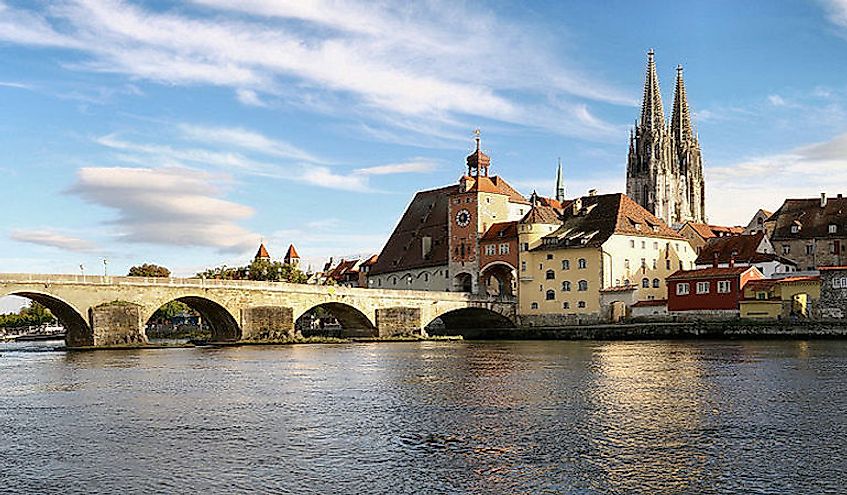Major Rivers Of Germany

Danube River is shared with nine other European countries, and it is the longest river to pass through Germany, while the Main is the longest river flowing entirely in Germany. Most of the rivers flowing through the country also source, drain, flow or pass through other European countries. Other rivers that flow solely in Germany are Weser (281 miles long) and Saale (257 miles long). Germany has one of the most developed river networks in the world. The rivers connect the European country to other European nations. Today, Germany taps this natural resource to produce one of the richest economies in the world.
Danube
The river rises from the Black Forest of Donaueschingen in Germany. It flows southeast through four capital cities including Vienna, Bratislava, Budapest, and Belgrade of Central Europe before draining in the black sea at Danube Delta. The Danube is the second longest river in Europe and the longest in Germany with 1,777 miles long. It passes through 9 other countries Serbia, Austria, Bulgaria, Romania, Slovakia, Croatia, Ukraine, and Moldova. It is a source of water to more than 20 million people and provides beautiful sceneries that attract more than six million tourists each year. The Naturpark Obere Donau is an important natural spot lying in the German portion of the Danube.
Rhine
River Rhine is the second largest river in Germany with 764 miles. The river sources from Lake Tomasee, and Paradies Glacier in Switzerland flows through the German cities of Karlsruhe, Mannheim, Wiesbaden, Bonn, and Duisburg. It also flows through Austria, and France where it serves as a boundary between Germany and France, before draining in the Hook, Rotterdam, Netherlands. It flows through many deep gorges and meanders with steep sided valleys of Vineyards and castles making it a prime tourist spot in Germany. It has many tributaries majorly the ILL, Main, Lahn, Neckar, and Ruhr.
Elbe
The Elbe river sources from the mountains in the Czech Republic to flow through the western and eastern parts of Germany. It then changes course to the northeast to empty into the North Sea at the port of Hamburg. It is 678 miles long and the rivers of Vltaza, Mulde, Ohre, Havel, Saale, and Schwarz Elster pours their waters in the Elbe River. In eastern Germany, the river serves as a river port to Torgau, Magdeburg, Aken, and Dessau among others. The river serves as the most historic river in Germany. It once separated East Germany from West Germany. Sources have it the remains of Adolf Hitler were scattered in the river to indicate his permanent departure.
Main
The river rises from Kulmbach in Franconia where the Red Main and White Main join to from the Main River. The White Main sources in the Fichtelgebirge mountains, while the Red Main from Franconia Jura. The river flows through the cities of Frankfurt am Main where it is the primary transportation artery and Wurzburg. The Main is navigable from the Rhine basin to Bamberg. Some dams and locks have been constructed on its course. The 2,200 miles long Main-Danube Canal connects the Main with the Danube and the Rhine rivers. The Main-Radweg is the most prominent German bicycle recreation course with over 370 miles. In the world War II era, the river separated Southern German Catholic population from Northern Germany Federation.
The Importance Of Rivers In Germany
The rivers in Germany have played a significant role in developing the country. German has one of the most developed inland navigation systems in the world thanks to all the rivers flowing through it, to or from other European countries. The rivers have also been a primary source for hydroelectric generation, recreational platforms, marking national borders and most importantly creating a vibrant ecosystem.
The construction of the Rhine-Danube Canal made the barge transportation of freight from the North Sea to the Black Sea possible. The Rhine river is the primary pillar of commerce and trade in Germany. The Rhine Valley is the most famous growing region of the Germany’s Riesling wine. The Oder river flowing through the boundaries of Poland and Germany provides a critical path for waterborne freight. The Elbe-Haviel Canal provides a transport route from Magdeburg to Berlin and Poland. Artists from all over the world have traveled to Germany just to capture the breathtaking beauty of a country with a unique biodiversity.
The Major Rivers Of Germany
| Rank | Major Rivers of Germany | Total Length |
|---|---|---|
| 1 | Danube | 1,777 miles (shared with 9 other countries) |
| 2 | Rhine | 764 miles (shared with 5 other countries) |
| 3 | Elbe | 678 miles (shared with the Czech Republic) |
| 4 | Oder | 531 miles (shared with Poland and the Czech Republic) |
| 5 | Moselle | 339 miles (shared with France and Luxembourg) |
| 6 | Main | 327 miles |
| 7 | Inn | 321 miles (shared with Austria and Switzerland) |
| 8 | Weser | 281 miles |
| 9 | Saale | 257 miles |
| 10 | Spree | 249 miles (shared with the Czech Republic) |











